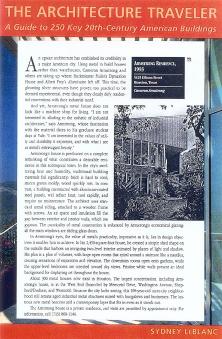go to... Amazon.com
The Architecture Traveler: A Guide to 250 Key 20th-Century American Buildings

Sydney LeBlanc
(W.W.Norton, 2000, 2005)
"In the 1990's, a provocative younger generation of architects made a strong national mark... a hopeful evolution toward an architecture that is both intellectually honest and widely appreciated. This evolution lays the groundwork for the twenty-first century: a passion for quality, a renewed dedication to materials and craftsmanship, and a desire to create a new American architecture that will capture the present and last over time."
An upstart architecture has established its credibility in a major American city. Using metal to build houses rather than warehouses, Cameron Armstrong and others are taking up where Buckminster Fuller's Dymaxion House and Albert Frey's Aluminaire left off. This time, the gleaming silver structures have proven too practical to be deemed experimental, even though they clearly defy residential conventions with their industrial motif.
And yet, Armstrong's metal house does not look like a machine shop for living. "l am not interested in alluding to the aesthetic of industrial architecture," says Armstrong, whose fascination with the material dates to his graduate student days at Yale. "I am interested in the values of utility and durability it expresses, and in what I see as metal's extravagant beauty."
Armstrong's house is predicated on a complete rethinking of what constitutes a desirable residence in this sub-tropical town. In the city's sweltering heat and humidity, traditional building materials fail significantly: brick is hard to cool; stucco grows moldy; wood quickly rots. In contrast, a building constructed with aluminum-coated steel panels, will reflect heat, cool rapidly, and require no maintenance. The architect uses standard metal siding, attached to a wooden frame with screws. An air space and insulation fill the gap between exterior and interior walls, which are gypsum. The practicality of metal construction is enhanced by Armstrong's economical glazing: all the main windows are sliding glass doors.
In Armstrong's eyes, the value of metal's practicality, impressive as it is, lies in design objectives it enables him to achieve. In his 2,450-square-foot house, he created a simple shed shape on the outside that harbors an intriguing two level interior animated by planes of light and shadow. His plan is a plan of volumes, with large open rooms that spiral around a staircase like a nautilus, creating sensations of expansion and elevation. The downstairs rooms open onto gardens, while the upper-level bedrooms are oriented toward sky views. Pristine white walls present an ideal background for displaying art throughout the house.
About 300 metal houses now exist in Houston. The largest concentration, including Armstrong's house, is in the West End (bounded by Memorial Drive, Washington Avenue, Shepherd, Durham, and Westcott). Because the city lacks zoning, this l00-year-old inner-city neighborhood still retains aged industrial metal structures mixed with bungalows and businesses. The lustrous new metal beacons add a contemporary layer that fits in even as it stands out.
The Armstrong house is a private residence, and visits are permitted by appointment only. For information, call 713-398-5207.
The Architecture Traveler: A Guide to 250 Key 20th-Century American Buildings, by Sydney LeBlanc (W.W. Norton, 2000), pp x, 221.
Reissued in 2005 as A Guide to 262 Key Modern American Buildings